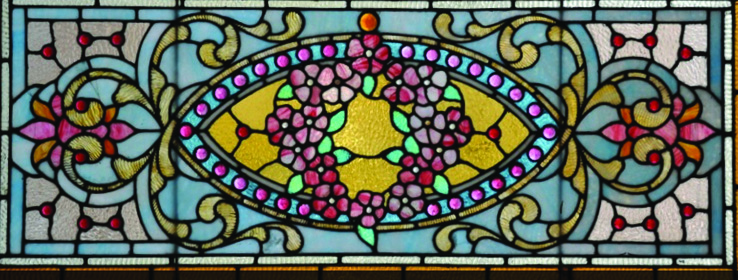By Megan Swoyer
Furniture designer Laura Scaccia specializes in creating one-of-a-kind, heirloom-quality tables out of colorful, often centuries-old stained-glass windows.
When Laura Scaccia sets out on a scavenger hunt for stained glass, it’s with a keen eye on color. “The colors have to speak to me,” says Scaccia, who’s amassed quite a collection of stained-glass windows — many of them removed from turn-of-the-century mansions in Pittsburgh and Cincinnati.
Scaccia owns Eclecticasa, a Michigan-based company that reclaims, restores and rehabs historic stained glass and creates original, heirloom-quality tables with it, repurposing and preserving it for future generations to use and enjoy.
The process
No two tables are alike. Scaccia draws her inspiration from the unique antique legs, staircase spindles and other architectural elements she also finds and salvages. Then it’s a matter of carefully matching the right legs to the right piece of stained glass, and deciding what type of wood to use for the surround. Whether the table then gets painted, stained and/or glazed, as well as with what hue, all depends on the colors in the stained glass.
“When I find gorgeous, dismantled stained glass, I’m drawn to its color combinations and its storied past. So much so that I have to preserve it,” Scaccia says. “By creating table structures that complement each piece of glass, I’m finding a new home for them. I’m giving them a new life.” In fact, her company’s name reinforces this theme: Eclecticasa comes from the words “eclectic” — stylish ideas from a wide range of resources — and “casa,” which means “home” in Italian.
Color preferences
“The era dictates the color,” Scaccia says. “Right now, we’re seeing a lot of pink, purple and fuchsia hues, so of course much of our furniture, apparel and contemporary stained glass reflect these hues. But me? I prefer historic color combinations. I treasure my Victorian glass pieces. They were once an important design feature in these magnificent homes and mansions that are, sadly, no longer standing. I find it so intriguing to realize these colors — stunning comminglings of intense jewel tones with more-subdued earth tones — were ‘in’ during that period.”
Scaccia likes to look at Sherwin-Williams historic color palettes for inspiration, and is reassured to see many of the same colors there that she sees in her stained-glass pieces.
“For example, in a piece of stained glass I call ‘Vaso,’ which means “vase” in Italian, I see a mingling of Buckram Binding (SW 0036) from the Roycroft Arts and Crafts Collection, and Alexandrite (SW 0060) and Blue Sky (SW 0063) from the Jazz Age Collection,” Scaccia says.
At the Michigan Design Center where she showcases pieces from her stained-glass table collection, the walls are painted in Sherwin-Williams hues. The Bunglehouse Blue (SW 0048) wall nicely complements her more historical pieces, while the
Butter Up (SW 6681) wall sets off her more contemporary pieces.





